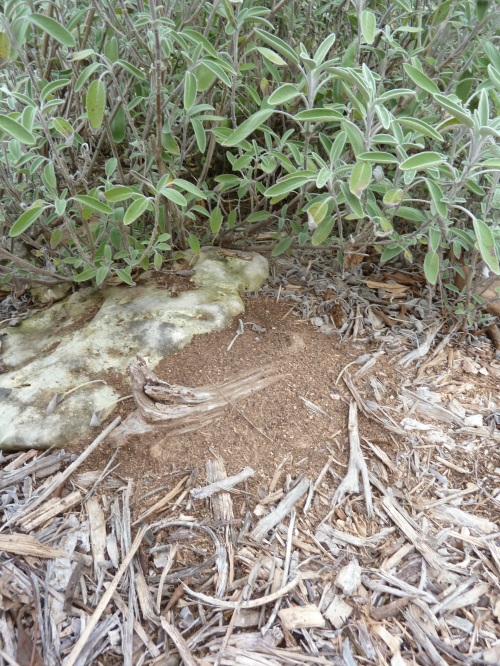Every spring, for the past five years, I am amazed at the mounds of fire ants that develop in our yard and garden areas. Almost overnight (not really) it just suddenly seems like they are everywhere.
I definitely have a love-hate relationship with fire ants (also known as red imported fire ants – solenopsis invicta). Love and hate are both pretty strong words to associate with fire ants, maybe it should be more “like” and “dislike.”
It is hard to have any nice and tender thoughts about fire ants when a few of them have attached themselves to your ankle or leg, and are stinging away. The fiery pain from the sting is finally reaching your brain and you are swiping them off you. As you hop around, stamping your feet, chances are a few not so pretty words might escape from your lips.
In reality the fire ant bite isn’t what causes the pain, they bite you in order to hang on and get a good grip so they can insert their stinger and get the venom in you…. that is when you start feeling the fire. Unlike the honey bee, the fire ant can sting you repeatedly and then get back to what ever it was they were doing.
 I will admit that I have taken great pleasure in wiping out mound after mound of fire ants using a locally made organic product called Anti Fuego that is made by Gardenville. The product is a concentrated mixture of things like molasses and orange oil (and a few other things) and it is designed to drench and conditions mounds and soils….. but it’s main purpose, for me, is to kill fire ants. After all, who wants fire ants around?
I will admit that I have taken great pleasure in wiping out mound after mound of fire ants using a locally made organic product called Anti Fuego that is made by Gardenville. The product is a concentrated mixture of things like molasses and orange oil (and a few other things) and it is designed to drench and conditions mounds and soils….. but it’s main purpose, for me, is to kill fire ants. After all, who wants fire ants around?
Well, I am going to ask you to have an open mind here. If we wipe out all the “bad” insects and bugs there will be nothing for the good guys to eat thus creating an unequal balance in the greater scope of things. I have understood that principle for many years, but fire ants? Come on! Really?
Yes, fire ants do have a purpose in life. That is really hard believe when you are being stung!
So, why would anyone want to keep them around? Fire ants voraciously consume populations of fleas, ticks, termites, cockroaches, chinch bugs, mosquito eggs and larva, scorpions, etc. That seems enough to persuade me to keep them around (within reason!)
I try to peacefully co-exist with them, and that isn’t always easy, but it is worth it for the good work that they do. I will let them do their work as long as they don’t take up residence in the walkways through the yard or in the gardens. It is an ongoing battle. This plan works for us , but that doesn’t mean it will work for others. Fire ants cause severe damage to cattle and wild life, and their mounds can cause terrible damage to farm equipment.
 In our yard, a few of the places that the fire ants love to take up residence are in my piles of composted horse manure, dirt/compost piles and under anything that lies on the ground (like a floor mat, garbage can, piece of plywood.) When I am loading my wheelbarrow with manure to take to the garden, I am very aware. When I go to the ranch to pick up piles of manure, I am even more aware. It is really no fun to be an hour from home, standing in a mound of fire ants while loading my truck with manure and have no way to treat the stings.
In our yard, a few of the places that the fire ants love to take up residence are in my piles of composted horse manure, dirt/compost piles and under anything that lies on the ground (like a floor mat, garbage can, piece of plywood.) When I am loading my wheelbarrow with manure to take to the garden, I am very aware. When I go to the ranch to pick up piles of manure, I am even more aware. It is really no fun to be an hour from home, standing in a mound of fire ants while loading my truck with manure and have no way to treat the stings.
When a fire ant stings you, you will feel immediate sharp pain that just seems to continue to burn and eventually will start to itch. Within 24 hours a raised white pustule forms and remains for several days. This isn’t an infection, but if you break it open you are increasing your chances of that area becoming infected (fun stuff huh!) People with diabetes or compromised immune systems have the potential for other problems, especially if they have been stung numerous times. While a few strings do not usually constitute a major medical emergency, there is a small percentage of people that develop allergic reactions to fire ant venom. These vary in intensity, but in the most extreme cases even a few stings can result in the life-threatening condition known as anaphylaxis.
I manage to get stung several times a year, usually around 3-7 stings at a time. They are always on my ankles and hands/wrists and are just plain bothersome. For me it is the sting and itch that feels OH SO GOOD when you itch it, but you never get any relief from itching it, just more sting and itch. I have tired several home remedies like baking soda paste, meat tenderizer and clear nail polish with no results of relief what so ever. So far, the only remedy that I have found that gives me any relief at all is Vick Vapor-rub! When I head out to pick up a load of manure or dirt I always make sure I have a jar of Vicks with me. I have the best results if I can get the Vicks on the sting locations immediately; if I wait just 5 minutes I will develop the red swelling bump, pain and itching, granted it is much less that it would be without applying the Vicks. In the photo above, I was stung 2-3 times and there is hardly a mark left because I applied the Vicks immediately!
I would like to work on making my own vapo-rub. Vicks active ingredients are camphor, eucalyptus and menthol and as I think about making my own fire-ant relieving variation, I think about rosemary, thyme and eucalyptus essential oils as a possible combination, maybe even some tea tree.
I don’t see fire ants moving out of our area any time in the near or distant future, so I will try to co-exist semi-peacefully with them and keep a jar of Vicks on hand until I can make up some of my own variation.
Do you have any secrets for dealing with fire ants in your area?
Sincerely, Emily
You can see what else I am up to over at Sincerely, Emily. The topics are varied, as I jump around from gardening to sewing to making bread or lotion and many things in between.























Need a quick pick-me-up? Read your SPAM!
Posted in Miscellaneous, Pest Control, tagged reading your SPAM, SPAM, SPAM Comments on September 22, 2012| 9 Comments »
No, I’m not talking about the Hormel tinned “meat” product made from what was formerly known as ham (Shoulder of Pork and Ham). No, I’m not talking about Society for the Publication of American Music, the Space Planning and Management, or the Solar Powered Area Monitor. What the heck am I talking about?
I am talking about the SPAM that you get on your blog in the SPAM box.
No, this sunflower doesn’t’ have anything to do with this post at all. It’s just pretty!
If you look in a dictionary you will find two definitions of SPAM:
“Inappropriate” and “irrelevant” pretty much covers most of it. And most of the time, it is just plain frustrating to see all that SPAM. From time to time I will find a legitimate comment that was routed to the SPAM folder. Aside from that, it is was it is… SPAM. Do they really think we are going to approve their comment with a link to something totally inappropriate and unrelated on all levels? Really? I don’t feel the need to advertise a certain Canadian Pharmacy that is selling certain enhancement drugs for amazingly low prices and I really am not interesting in pursuing the real estate in _______ (fill in the blank with what ever place you want to.)
In my book, there is a third type of SPAM comment – the one that can really lift your spirits and make you feel good (even though it still truly is SPAM!) These people take time out of their busy day to say words of encouragement and send me a link to their website – where I might find such helpful things as real estate, or where to buy gold or silver or even find pharmaceuticals in Canada. And let’s not loose that link to buying plastics on line or a certain special dating service in the Netherlands.
I must say, the encouraging words are so nice to read, but completely make no sense when you look at what post they have comments on…. “you have awesome ideas that you know how to express in so easy way” posted on Sunday Photos: Red! Well, I am glad photos of “red” made sense to you and that you think I know how to “express” it in such and “easy way.”
Not only do we (the wonderful contributors at NDIN) have such awesome ideas, but we get a lot of “thank you’s” and “appreciation” from these Spammers:
We are motivational, we are hard workers, we have great ideas:
It is so nice to know we are being helpful and informative (and intelligent too):
Do you think the spammers think that if they are complimentary and nice in the SPAM comments that I will be smiling and think they are so nice that I should just click on their link to see what it is really about? Aahh, NO! The only reason I skim through the comments is to make sure a legitimate comment didn’t get over there by accident.
Has any of the SPAM comments in your box caught your attention before?
Sincerely, Emily
You can see what else I am up to over at Sincerely, Emily. The topics are varied, as I jump around from gardening to sewing to making bread or lotion and many things in between.
Share this:
Read Full Post »